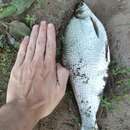en
names in breadcrumbs


Parabramis pekinensis és una espècie de peix de la família dels ciprínids i de l'ordre dels cipriniformes.
És un peix d'aigua dolça i de clima temperat (10°C-20°C).[6][7]
Es troba a Àsia: des de la conca del riu Amur fins a Xangai (la Xina).[6][8][9][10][11][12][13][14][15][16][17][18][19][20][21][22][23][24]
És un dels peixos comercials més importants de la Xina per la seua carn saborosa, tot i que és molt espinós.[25]
Parabramis pekinensis és una espècie de peix de la família dels ciprínids i de l'ordre dels cipriniformes.
The white Amur bream (Parabramis pekinensis) is a species of cyprinid freshwater fish, of the monotypic genus Parabramis. It is native to eastern Asia, where found from the Amur River basin in Russia south to Ningpo and Shanghai in China.[1] It is an important food fish,[1] and has been introduced to regions outside its native range.
The species was originally described as Abramis pekinensis. The name is derived from the Greek word para, meaning "the side of ", and the Old French word breme, a type of freshwater fish.
The white Amur bream (Parabramis pekinensis) is a species of cyprinid freshwater fish, of the monotypic genus Parabramis. It is native to eastern Asia, where found from the Amur River basin in Russia south to Ningpo and Shanghai in China. It is an important food fish, and has been introduced to regions outside its native range.
The species was originally described as Abramis pekinensis. The name is derived from the Greek word para, meaning "the side of ", and the Old French word breme, a type of freshwater fish.
Parabramis pekinensis es una especie de peces de la familia de los Cyprinidae en el orden de los Cypriniformes.
Come plantas acuáticas
Es un pez de agua dulce y de clima templado (10°C-20°C).
Se encuentran en Asia: desde la cuenca del río Amur hasta Shanghái (la China ).
Parabramis pekinensis es una especie de peces de la familia de los Cyprinidae en el orden de los Cypriniformes.
Parabramis pekinensis Parabramis generoko animalia da. Arrainen barruko Actinopterygii klasean sailkatzen da, Cyprinidae familian.
Parabramis pekinensis Parabramis generoko animalia da. Arrainen barruko Actinopterygii klasean sailkatzen da, Cyprinidae familian.
Amurinlahna (Parabramis pekinensis) on särkikalojen heimoon kuuluva makean veden kalalaji. S. I. Basilewsky kuvasi lajin ensimmäisen kerran vuonna 1855. Laji on peräisin Itä-Aasiasta, Amur-joen altaasta. Amurinlahnaa pidetään tärkeänä talouden kannalta, ja sitä ollaankin tuotu lajin alkuperäisten alueiden ulkopuolelle.
Amurinlahna on suurikokoinen kala; ulkonäöltään se muistuttaa suuresti lahnaa. Evät ja pyrstö ovat harmaat, hieman punertavat. Amurinlahnan erikoisen pitkä peräevä tuo mieleen sulkavan. [1]
Amurinlahna (Parabramis pekinensis) on särkikalojen heimoon kuuluva makean veden kalalaji. S. I. Basilewsky kuvasi lajin ensimmäisen kerran vuonna 1855. Laji on peräisin Itä-Aasiasta, Amur-joen altaasta. Amurinlahnaa pidetään tärkeänä talouden kannalta, ja sitä ollaankin tuotu lajin alkuperäisten alueiden ulkopuolelle.
Parabramis pekinensis is een straalvinnige vis uit de familie van karpers (Cyprinidae) en behoort derhalve tot de orde van karperachtigen (Cypriniformes). De vis kan maximaal 55 cm lang en 4100 gram zwaar worden.
Parabramis pekinensis is een zoetwatervis. De vis prefereert een gematigd klimaat. Het verspreidingsgebied beperkt zich tot Azië.
Parabramis pekinensis is voor de visserij van groot commercieel belang. In de hengelsport wordt er weinig op de vis gejaagd.
Parabramis pekinensis is een straalvinnige vis uit de familie van karpers (Cyprinidae) en behoort derhalve tot de orde van karperachtigen (Cypriniformes). De vis kan maximaal 55 cm lang en 4100 gram zwaar worden.
Leszczak biały[2], leszczak[3], leszcz amurski biały[4], leszcz amurski[5], leszcz biały[5] (Parabramis pekinensis) – gatunek słodkowodnej ryby z rodziny karpiowatych (Cyprinidae). Jedyny przedstawiciel rodzaju Parabramis.
Chiny, na wyspach Tajwan i Hajnan oraz w dorzeczu rzeki Amur od miasta Błagowieszczeńsk w Rosji.
Z wyglądu i budowy ciała jest podobny do leszcza. Ciało wysokie i bocznie spłaszczone, płetwa grzbietowa zaopatrzona jest w kolec, po stronie brzusznej ciała od płetw piersiowych aż po otwór odbytowy widoczna jest krawędź zwana kilem.
Dorasta do 55 cm długości i 4 kg masy ciała[6].
Składana ikra jest typu pelagicznego, jest lżejsza od wody i w strefie pelagialnej rozwija się. Początkowo narybek odżywia się planktonem, z wiekiem przechodzi na pokarm roślinny i denny bentos.
Wartość smakowa mięsa jest duża, wadą jest duża ościstość ciała.
Leszczak biały, leszczak, leszcz amurski biały, leszcz amurski, leszcz biały (Parabramis pekinensis) – gatunek słodkowodnej ryby z rodziny karpiowatych (Cyprinidae). Jedyny przedstawiciel rodzaju Parabramis.